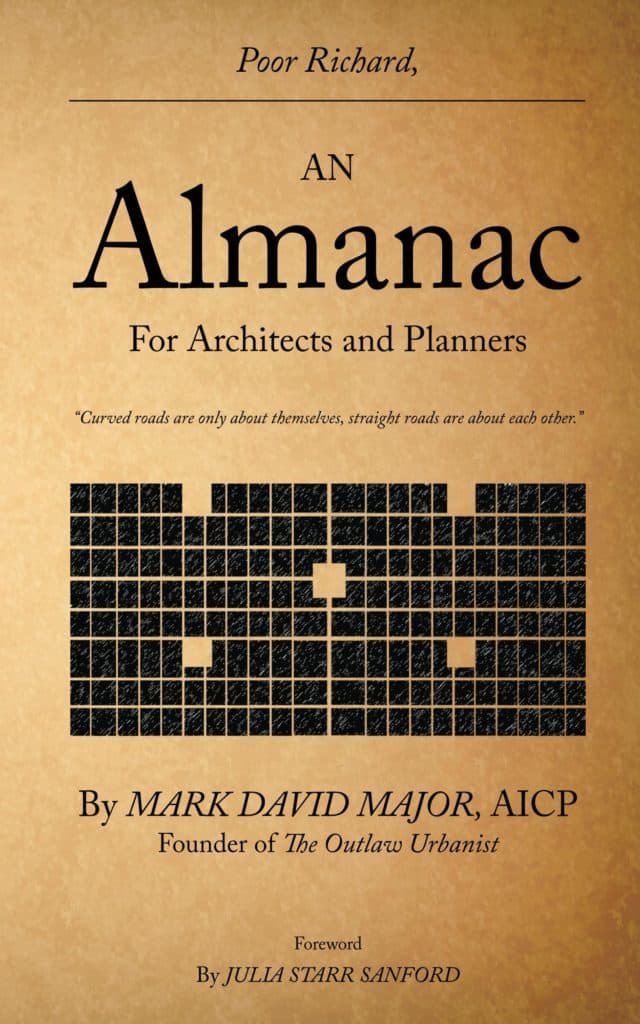IN THE OUTLAW URBANIST, January 4, 2013
A unanimous Declaration of Planning Independence
When in the Course of urban events, it becomes necessary for a people to overthrow the tired paradigm which has guided city building for too long, and to assume a new model of urban growth and renewal for our cities on this earth, the distinct and equal status to which the Laws of Common Sense and of Common Sense’s Spirit entitles them, a decent respect to the opinions of mankind requires that they should declare the causes which impel them to revolution.
 We hold these truths to be proven fact, that all cities are created of space, that space is a living thing, which is endowed by human Design with certain indeniable attributes, that among these are Movement, Transaction, and the pursuit of Interaction. That to secure these attributes, Urban Designers and Planners are instituted among Men, deriving their just powers from the Beingness of the City, that whenever any paradigm becomes destructive of these ends, it is the Right of the People to alter or abolish it, and to institute a new Paradigm, laying its foundation on such common sense and organizing its principles in such form, as to them shall to most likely perpetuate the vitality and sustainability of the City.
We hold these truths to be proven fact, that all cities are created of space, that space is a living thing, which is endowed by human Design with certain indeniable attributes, that among these are Movement, Transaction, and the pursuit of Interaction. That to secure these attributes, Urban Designers and Planners are instituted among Men, deriving their just powers from the Beingness of the City, that whenever any paradigm becomes destructive of these ends, it is the Right of the People to alter or abolish it, and to institute a new Paradigm, laying its foundation on such common sense and organizing its principles in such form, as to them shall to most likely perpetuate the vitality and sustainability of the City.
Scientific method, indeed, will dictate that a Paradigm long established should not be changed for light and transient causes; and accordingly all experience has shown, that mankind are more disposed to suffer, while Its evils are sufferable, than to right themselves by overthrowing a Paradigm to which they are accustomed. But when a long train of abuses and corruptions, pursuing invariably the same Object manifests a Design to reduce them under absolute Lunacy, it is their right, it is their duty, to throw off such Paradigm, and to provide a new model for the future of the city.
Such has been the patient sufferance of our cities; and such is now the necessity that constrains us to overthrow our current System of City Building. The history of the current Paradigm is a history of repeated injuries and corruptions, all having in direct object the establishment of absolute Lunacy over our cities. To prove this, let Facts be submitted to a candid world:
It has refused to Assent to the wisdom of good Design, the most wholesome and necessary for the public good, found common over 10,000 years of city building.
It has passed Laws and Regulations contrary to the common wisdom of good Design over 10,000 years of city building, refused to reform or suspend such Laws and Regulations when proven fallacious, or lest utterly neglected to attend to them for the public good.
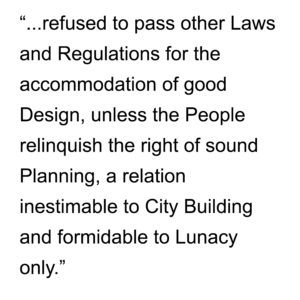 It has refused to pass other Laws and Regulations for the accommodation of good Design, unless the People relinquish the right of sound Planning, a relation inestimable to City Building and formidable to Lunacy only.
It has refused to pass other Laws and Regulations for the accommodation of good Design, unless the People relinquish the right of sound Planning, a relation inestimable to City Building and formidable to Lunacy only.
It has conspired to call together Professionals at places unusual, uncomfortable, and distant from Public view, for the sole purposes of corrupting and fatiguing the City into compliance with Its measures.
It has dissolved Common Sense repeatedly, for opposing with manly firmness Its invasions on the vital humanism of the City.
It has conspired for a long time, after such dissolutions, to promote mediocre Professionals; whereby the Paradigm, incapable of Annihilation, have been applied to Cities at large without recourse nor correction; the City remaining in the mean time exposed to all the dangers from without, and convulsions within.
It has endeavored to prevent the good Design of these cities; for that purpose of obstructing the Common Sense building of the City; refusing to pass Laws and Regulations to encourage good Design, and raising the conditions for the Misappropriation of Lands and Social Isolation of Populations.
It has obstructed the Administration of Space for pedestrians, by promoting its Assent to Laws for accommodating the Automobile.
It has made the People dependent on the Automobile alone, for the movement, transaction and interaction of their everyday activities, and increased the time and cost of their livelihood in Urban conditions.
It has erected a multitude of New Laws and Regulations, and sent hither swarms of Attorneys to harass our people, and eat out their substance.
It has kept among us Allocations for Parking designed solely for a handful days of Christmas shopping without regard for times or amount of use in the rest of the Year.
It has affected to render the desires of Professionals independent of and superior to the Civic good.
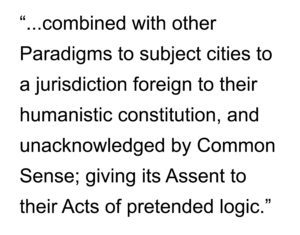 It has combined with other Paradigms to subject cities to a jurisdiction foreign to their humanistic constitution, and unacknowledged by Common Sense; giving its Assent to their Acts of pretended logic.
It has combined with other Paradigms to subject cities to a jurisdiction foreign to their humanistic constitution, and unacknowledged by Common Sense; giving its Assent to their Acts of pretended logic.
For Quartering large bodies of automobiles on our roads: For protecting them, by idiotic regulations, from retardation for any Murders which they have commit on Pedestrians and Bicyclists in our Cities:
For isolating our urban centers from all parts of their Periphery:
For imposing Fees and Taxes on us without benefit to the Civic good:
For depriving us in many cases, of the benefits of Choice in our housing types:
For placing the transportation of Automobiles above the Humanity of living:
For abolishing diversity in Our Cities for the sake of suburban conformity, establishing therein an Arbitrary lifestyle, and enlarging its Model so as to render it at once an example and fit instrument for introducing the same absolute Lunacy in our Cities:
For destroying our Street Life, abolishing its most valuable Character, and altering fundamentally the spatial Function of Our Cities:
For suspending Common Sense urbanism, and declaring itself invested with the power to Build Suburbs for us in all cases whatsoever:
It has abdicated Common Sense here, by declaring us inconsequential to City Building and waging War against traditional urbanism:
It has plundered our lands, destroyed the Social Contract between the City and its Citizens, promoted social isolation, and destroyed the fabric of our neighborhoods.
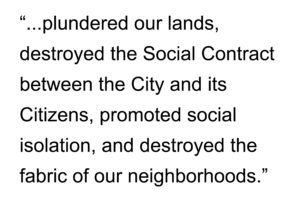 It is at this time renewing efforts to sprawl large suburban communities of suspect Value to complete the works of isolation, desolation and lunacy, already begun with circumstances of Euclidean zoning and deceits of transportation engineering and planning scarcely paralleled in the most barbarous ages, and totally unworthy as a model of City Building lest the Death of the City is its aim.
It is at this time renewing efforts to sprawl large suburban communities of suspect Value to complete the works of isolation, desolation and lunacy, already begun with circumstances of Euclidean zoning and deceits of transportation engineering and planning scarcely paralleled in the most barbarous ages, and totally unworthy as a model of City Building lest the Death of the City is its aim.
It has constrained our fellow Citizens taken Captive in a web of bureaucratic incompetence in all agencies against their Cities, to become the executioners of Urban Vitality and Sustainability, or to fail by their Hands.
It has excited domestic special interests against the City, and has endeavored to bring on the Death of our Cities at the hands of faceless suburban sprawl, whose known rule of assimilation is an undistinguished conformity of all ages, sexes and conditions.
In every stage of these Oppressions We have petitioned for Redress in the most humble terms:
Our repeated Petitions have been answered only by repeated injury.
A Paradigm whose character is thus marked by every act which may define Lunacy, is unfit to be a model for Great Cities.
Nor have Urban Designers and Planners been wanting in attentions to our plight. They have been warned from time to time of attempts by their Paradigm to extend its unwarrantable reign over our Cities. Urban Designers and Planners have been reminded of the flaws of their Paradigm, and they have been conjured by the ties of our common kindred to disavow these corruptions, which,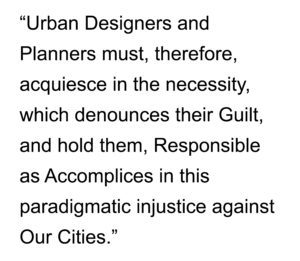 would inevitably spurn revolution. Urban Designers and Planners too have been deaf to the voice of Common Sense and Accepted Wisdom. Urban Designers and Planners must, therefore, acquiesce in the necessity, which denounces their Guilt, and hold them, Responsible as Accomplices in this paradigmatic injustice against Our Cities.
would inevitably spurn revolution. Urban Designers and Planners too have been deaf to the voice of Common Sense and Accepted Wisdom. Urban Designers and Planners must, therefore, acquiesce in the necessity, which denounces their Guilt, and hold them, Responsible as Accomplices in this paradigmatic injustice against Our Cities.
We, therefore, The Outlaw Urbanist, in General Congress, Assembled, appealing to the our Ancestral history and the wisdom of Master Builders for the righteousness of our cause, do, in the Name, and by Authority of the good People of our Cities, solemnly publish and declare, that Our Cities are, and of Right ought to be Free of the Prevailing Paradigm; that we are Absolved from All Allegiance to the Prevailing Paradigm; and that all political and moral connection between It and City Building is and ought to be totally overthrown; and that as Free and Independent Thinkers, we have full Power to build traditional cities, foster movement, transaction and social interaction in Cities made of Space, and to do all other Acts and Things which Independent Thinkers may of right do. And for the support of this Declaration, with firm reliance on the protection of Common Sense in the Human Spirit, we pledge each other our Lives, our Fortunes and our sacred Honor.

This article appears in Major, M.D. (2012) Poor Richard, An Almanac for Architects and Planners (Volume 1 with Foreword by Julia Starr Sanford). Jacksonville, Florida: Forum Books, ISBN-10: 1482659379, ISBN-13: 978-1482659375, ASIN: B00Q1V5VLK. Available for purchase on this page.
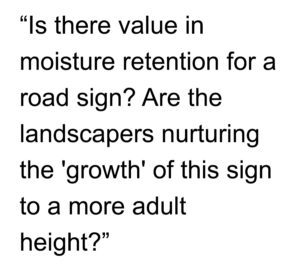 Is there value in moisture retention for a road sign? Are the landscapers nurturing the ‘growth’ of this sign to a more adult height? Or perhaps additional moisture will enable the speed limit to grow above its current 15 MPH level? Is this what occurred with the overflow pipe? Was it originally only six inches in height and, over time, the additional moisture retention of mulching around the pipe enabled its growth an imposing height of two feet? Fire hydrants certainly require water in order to operate (upper right) but I’m pretty sure mulching has nothing to do with how they get water. Finally, why mulch around an electrical transformer (lower right)? It sits on a concrete pad, which is already well-hidden by the grass. Surely this was the point of painting them green in the first place, so they would be less noticeable. Personally, I didn’t even know they existed until they mulched around the base (read: sarcasm).
Is there value in moisture retention for a road sign? Are the landscapers nurturing the ‘growth’ of this sign to a more adult height? Or perhaps additional moisture will enable the speed limit to grow above its current 15 MPH level? Is this what occurred with the overflow pipe? Was it originally only six inches in height and, over time, the additional moisture retention of mulching around the pipe enabled its growth an imposing height of two feet? Fire hydrants certainly require water in order to operate (upper right) but I’m pretty sure mulching has nothing to do with how they get water. Finally, why mulch around an electrical transformer (lower right)? It sits on a concrete pad, which is already well-hidden by the grass. Surely this was the point of painting them green in the first place, so they would be less noticeable. Personally, I didn’t even know they existed until they mulched around the base (read: sarcasm).
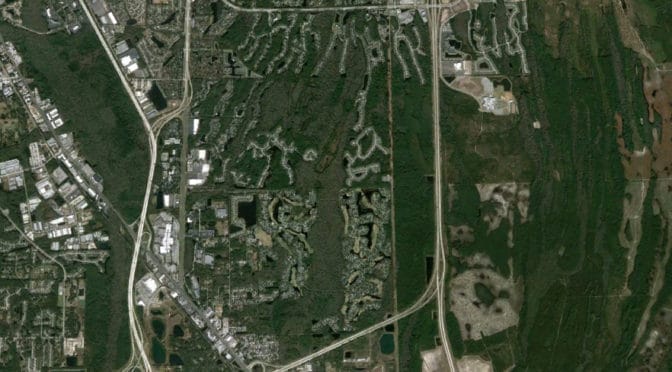
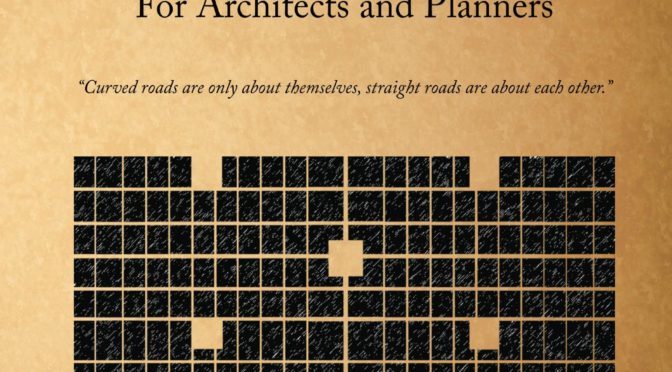
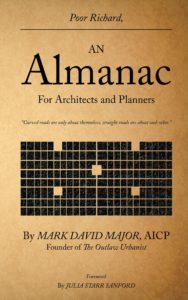
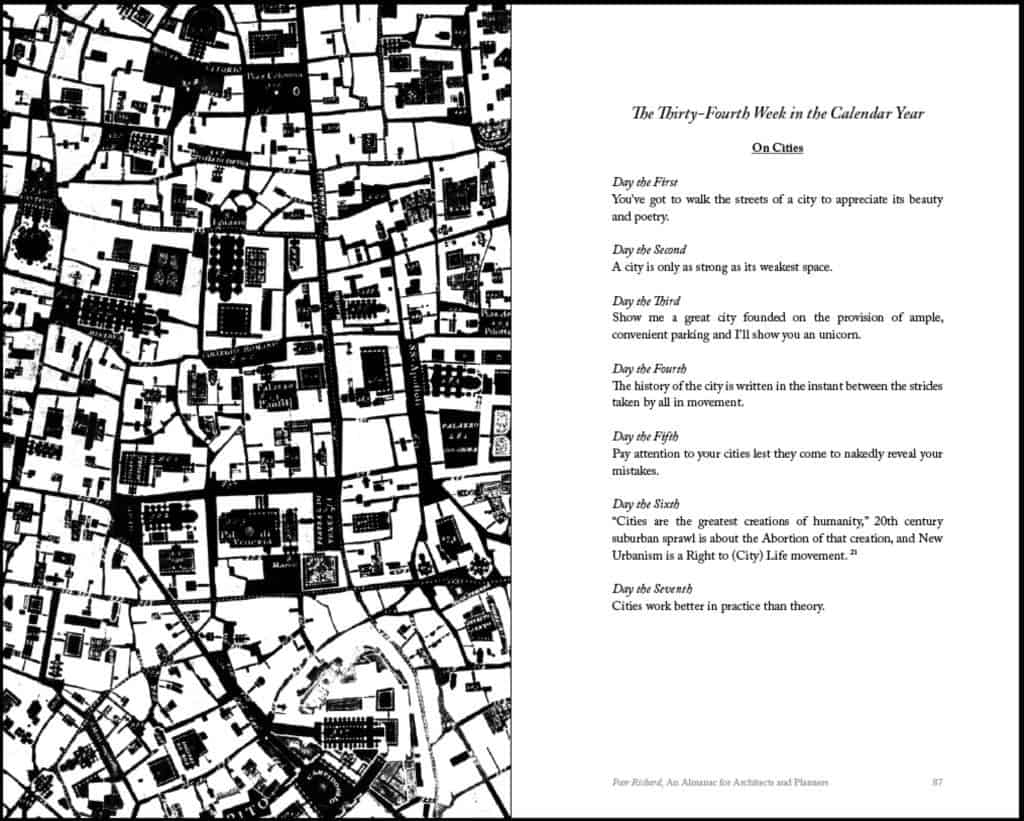

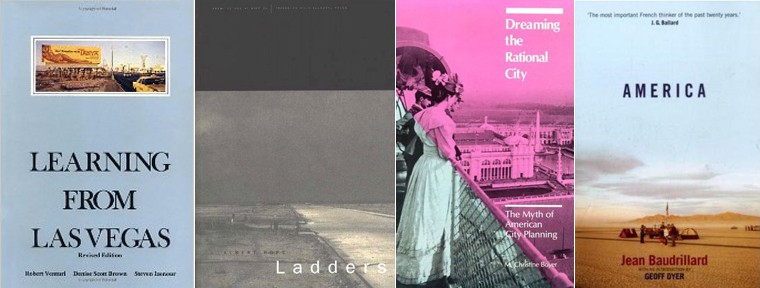

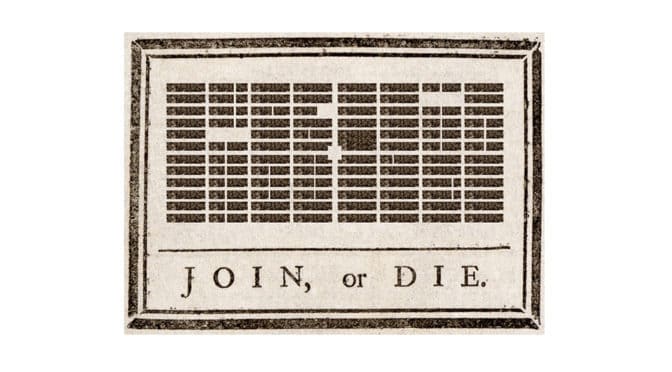
 We hold these truths to be proven fact, that all cities are created of space, that space is a living thing, which is endowed by human Design with certain indeniable attributes, that among these are Movement, Transaction, and the pursuit of Interaction. That to secure these attributes, Urban Designers and Planners are instituted among Men, deriving their just powers from the Beingness of the City, that whenever any paradigm becomes destructive of these ends, it is the Right of the People to alter or abolish it, and to institute a new Paradigm, laying its foundation on such common sense and organizing its principles in such form, as to them shall to most likely perpetuate the vitality and sustainability of the City.
We hold these truths to be proven fact, that all cities are created of space, that space is a living thing, which is endowed by human Design with certain indeniable attributes, that among these are Movement, Transaction, and the pursuit of Interaction. That to secure these attributes, Urban Designers and Planners are instituted among Men, deriving their just powers from the Beingness of the City, that whenever any paradigm becomes destructive of these ends, it is the Right of the People to alter or abolish it, and to institute a new Paradigm, laying its foundation on such common sense and organizing its principles in such form, as to them shall to most likely perpetuate the vitality and sustainability of the City. It has refused to pass other Laws and Regulations for the accommodation of good Design, unless the People relinquish the right of sound Planning, a relation inestimable to City Building and formidable to Lunacy only.
It has refused to pass other Laws and Regulations for the accommodation of good Design, unless the People relinquish the right of sound Planning, a relation inestimable to City Building and formidable to Lunacy only. It has combined with other Paradigms to subject cities to a jurisdiction foreign to their humanistic constitution, and unacknowledged by Common Sense; giving its Assent to their Acts of pretended logic.
It has combined with other Paradigms to subject cities to a jurisdiction foreign to their humanistic constitution, and unacknowledged by Common Sense; giving its Assent to their Acts of pretended logic. It is at this time renewing efforts to sprawl large suburban communities of suspect Value to complete the works of isolation, desolation and lunacy, already begun with circumstances of Euclidean zoning and deceits of transportation engineering and planning scarcely paralleled in the most barbarous ages, and totally unworthy as a model of City Building lest the Death of the City is its aim.
It is at this time renewing efforts to sprawl large suburban communities of suspect Value to complete the works of isolation, desolation and lunacy, already begun with circumstances of Euclidean zoning and deceits of transportation engineering and planning scarcely paralleled in the most barbarous ages, and totally unworthy as a model of City Building lest the Death of the City is its aim. would inevitably spurn revolution. Urban Designers and Planners too have been deaf to the voice of Common Sense and Accepted Wisdom. Urban Designers and Planners must, therefore, acquiesce in the necessity, which denounces their Guilt, and hold them, Responsible as Accomplices in this paradigmatic injustice against Our Cities.
would inevitably spurn revolution. Urban Designers and Planners too have been deaf to the voice of Common Sense and Accepted Wisdom. Urban Designers and Planners must, therefore, acquiesce in the necessity, which denounces their Guilt, and hold them, Responsible as Accomplices in this paradigmatic injustice against Our Cities.